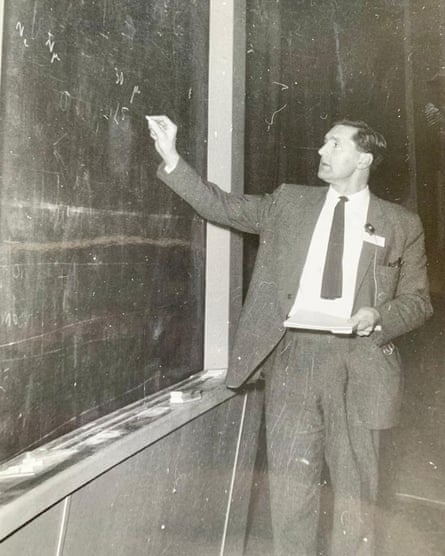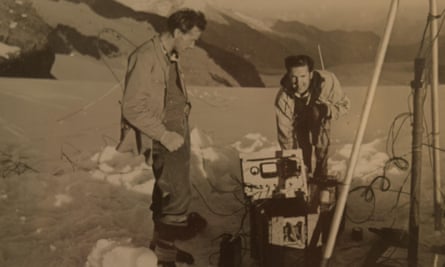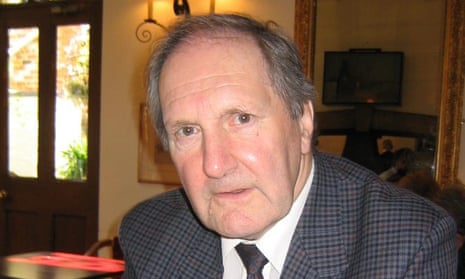The particle physicist Donald Perkins, who has died aged 97, made seminal discoveries about the structure of the proton, and nuclear interactions at extreme energies, and first proposed the use of beams of pion particles in cancer therapy. His career spanned the birth of particle physics, as it emerged from studies of cosmic rays in the 1940s, through its maturation in the final decades of the last century, to the climactic discovery of the Higgs boson in the 21st. He played key roles throughout.
When Perkins began research in 1948, the electron, proton and neutron were the only known fundamental particles whose role in building atoms was understood. The pion, a particle predicted to carry the strong force that binds atomic nuclei, had recently been discovered in cosmic rays by Cecil Powell of Bristol University, and it was in Powell’s group that Perkins began his research career.
Powell had pioneered the use of photographic emulsions to study cosmic rays. The technique involved going to high altitudes, such as the Pic du Midi, or using specially adapted weather balloons, to get best access to the rays. Perkins’ supervisor was GP Thomson, who had been active in the second world war, and Perkins asked him to arrange for a flight from RAF Benson in Oxfordshire to take his photographic emulsion up 30,000 feet and fly it around for several hours.

During the next few years Perkins obtained several significant images of pions in action. He was the first to observe the nuclear capture of the negatively charged pion and obtained evidence that the pion is unstable. With Powell and Peter Fowler, Perkins published an encyclopedia of emulsion images of the interactions of cosmic rays, The Study of Elementary Particles by the Photographic Method (1959), which was the state of the art in the field. In 1961, Perkins and Fowler first suggested the use of pion beams as a cancer therapy.
Discoveries in cosmic rays inspired the birth of high-energy particle physics using terrestrial accelerators, which led to the discovery of a veritable zoo of particles. That most of these are not fundamental was suspected, but not until 1968 was there direct evidence that the proton, and by implication others, are composed of more fundamental particles. The breakthrough had come from experiments at Stanford, California, where electrons were used to probe inside the proton and neutron. That the fundamental constituents are quarks, however, was only established in 1972, thanks to an insight by Perkins.
Among the avalanche of particle discoveries had been that of the neutrino, in 1956. This electrically neutral sibling of the electron fascinated him. After becoming professor of elementary particle physics at Oxford University in 1965, where he built the modern department of nuclear physics with Denys Wilkinson and Ken Allen, Perkins began to use beams of neutrinos, at the Cern laboratory in Geneva, as probes of the proton. There he was directly involved in two breakthrough discoveries that inspired the modern standard model of particles and forces.
Perkins was well informed about the Stanford experiments with electrons and immediately, in 1968, convinced a newly formed collaborative team using Cern’s Gargamelle bubble chamber that beams of neutrinos could provide a complementary view of the proton’s inner structure. This idea dominated the neutrino programme at Cern, and by 1972 their data enabled the electric charges of those constituents to be measured. The result: the proton and neutron are built of quarks, bound together by gluons. By 1973 this had inspired development of the modern quantum chromodynamics theory of the strongly interacting particles, a key foundation of the standard model.
The strong nuclear force was understood, but the weak force, whose most familiar role is in fuelling the sun and in causing forms of radioactivity, remained an enigma. A novel theory, uniting the weak force with the electromagnetic force, now received its first confirmation thanks to Perkins and the Gargamelle group. Neutrinos are a unique probe of the weak force. They were known to pick up electric charge when interacting with protons, but the emerging theory uniting electromagnetic and weak interactions required the existence of a previously unseen consequence of the weak force in which neutrinos bounce off protons unchanged.

The Gargamelle experiment played a leading role in establishing the existence of these “neutral currents”, which paved the way for eventual confirmation of the unified theory and Nobel prizes in 1979 for its theoretical creators, Sheldon Glashow, Abdus Salam and Steven Weinberg. At the time of their award, the agents of unification, the massive W and Z bosons, were not yet discovered. The Gargamelle results, much driven by Perkins, were deemed sufficient proof by the Nobel committee.
Perkins was a member of Cern’s scientific policy committee from 1981 to 1986, and latterly its chair, a period when LEP, the Large Electron-Positron Collider and precursor to the current Large Hadron Collider was being built. With the standard model established, the long march to find its fulcrum, the Higgs boson, began. Perkins’ graduate textbook, Introduction to High Energy Physics, first published in 1972, is now in its fourth edition and continues to educate and inspire new generations of particle physicists working at the Large Hadron Collider.
Born in Hull, east Yorkshire, Donald was the son of Gertrude and George Perkins, teachers of, respectively, English and maths. Educated at the city’s Malet Lambert high school, he went on to Imperial College London, where he gained a BSc in physics in 1945 and his doctorate in 1948. He was a senior scholar of the Royal Commission for the Exhibition of 1851 for three years, before becoming an associate in physics in 1951 at the University of Bristol. After a year at the Lawrence radiation laboratory, at Berkeley in California, he returned to Bristol in 1956 as a lecturer in physics, appointed a reader in 1960. He was at Oxford University, where he was a fellow of St Catherine’s College, from 1965 until his retirement in 1993.
Having been elected fellow of the Royal Society in 1966, he won the society’s Royal Medal in 1997. He was made a CBE in 1991.
Perkins married Dorothy Maloney in 1955. She died in 2021, and he is survived by their two daughters, Venetia and Michele.

Comments (…)
Sign in or create your Guardian account to join the discussion